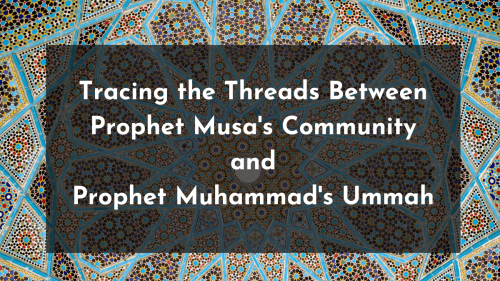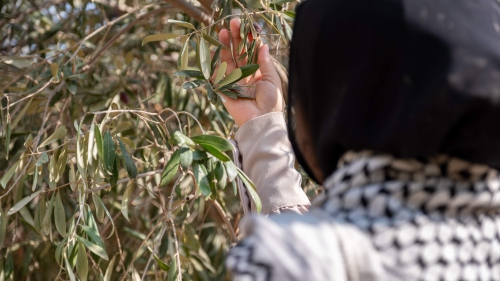Sunnah Superfoods: A Path to Well-Being
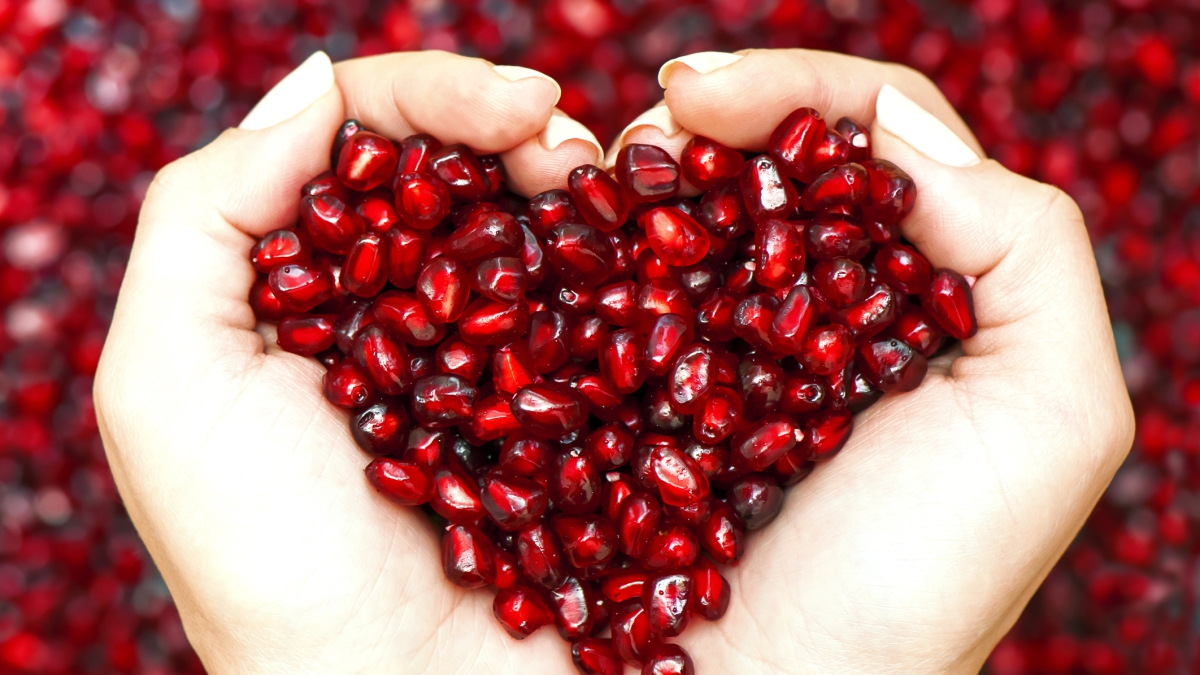
Health Benefits: Prophet Muhammad ﷺ Recommended Superfoods
Abstract
Nutrition and other bioactive natural products present in specific foods within a balanced diet play an indispensable role in maintaining and promoting human health. Plants are rich sources of balanced nutrition because of a high content of bioactive products; hence, most of them have recently acquired the status of superfoods. It has been used since ancient times for the treatment of various ailments, and these traditional medicines still remain one of the most affordable and easily accessible sources of treatment in the primary healthcare system. The scientifically based use of these superfoods dates back to the era of Prophet Muhammad ﷺ along with other historical uses of plant products. Prescription of a large number of herbal foods such as dates, pomegranates, olives, figs, grapes, and black seeds was successfully proposed by him. These recently have become superfoods with their powerful healing properties and act as favorable dietary interventions for disease prevention as well as for the good maintenance of health. The use of these foods as ingredients of natural origin with fewer side effects seems to be more favorable than the chemical treatment, which is often complicated. The present review is an attempt to provide a brief survey of the literature on the scientifically based significance of these superfoods carried out by various researchers and exploration of a wide spectrum of their pharmacological actions, which include antidiabetic, anticancer, immune modulator, analgesic, anti-inflammatory, and hepatoprotective properties.
Introduction
There is a myriad of diverse flora available on our earth, having powerful medicinal values to prevent or cure several human diseases. Many of them are considered superfoods due to their high and varied contents of a large number of natural bioactive products, which have immense health benefits. Superfoods include a class of most potent, super concentrated, and nutrient-rich foods having an abundance of synergetic elements in their natural state, which work together in the human body. Besides having good taste, superfoods have the ability to enormously increase the vital force and energy of one’s body and are the best choice for improving overall health.[1,2]
In addition to providing nourishment to the body, food has played a vital role in the management of various diseases since the dawn of civilization, and hence, they are our natural safe bet of late. There has been a long history of the use of plant-based foods against human ailments. They have been used since the time of Prophet Muhammad (Peace Be Upon Him). He had prescribed the use of foods rich in nutrients that can counter the effects of substances that have been proven to be harmful. He had recommended certain foods such as dates, olives, figs, pomegranates, black seeds, grapes, and many others for alleviating several ailments. Prophetic recommendations of food are remarkable for their prescience, as they came centuries before research was conducted on healthy diet and their benefits to the body.[3,4]
There are tremendous advances made in allopathic medical practices, which sometimes have been proven to have drastic effects on humans.[5] In recent years, treatment strategies have focused on the development of novel curative options with no side effects. Sunnah (prophetic tradition) advocates the pre-date use of food as medicines by many centuries, serving as precursors to the principles of modern treatment. According to one of the Prophet Muhammad ﷺ statements, “The one who sent down the disease sent down the remedy, and for each disease, Almighty has given a cure.” People are encouraged to seek out those remedies and use them with skill and kindness.[6]
Prophet Muhammad's ﷺ recommended foods have now become superfoods of the day for their powerful healing properties, which are now becoming known to us. These are being practiced even today; however, still, our knowledge regarding the active ingredients of these plants and their products, which have powerful phytochemical and pharmaceutical actions, is poorly understood. There are no proper scientific validations and despite a treasure of phytomedicines, ailments such as cancer, obesity-related hypertension, diabetes, and many incurable diseases are on the rise. There is an urgent need to review the historically prescribed superfood-derived drugs for their state-of-the-art development and use. Hence, the present review highlights the therapeutic potentials of Prophet Muhammad ﷺ recommended plant-based superfoods and their constituents against many incurable human ailments.
Most Common Life-threatening Diseases and Their Treatment Approaches
Cancer is a major cause of death worldwide. Development of cancer gets started from the uncontrolled growth of cells to the development of primary tumors, vascularization, and its consequent spread to other body parts, where secondary tumors may form. The common types of cancers leading to overall mortality are lung, liver, stomach, breast, and colon. There are a number of treatment techniques that are in use or under development today to cure these types of cancers, which are commonly grouped into five categories: Radiation, surgery, chemotherapy, hormonal therapy, and immunotherapy.[7,8]
Apart from various treatment approaches, chemotherapy is one of the chief therapeutic approaches to combat cancer. The main objective of the ideal cancer chemotherapy is to deliver the exact amount of drug with a desired controlled rate and for a satisfactorily long duration of time to the site of action, preventing the normal cells from obtaining a therapeutic response.[9] However, there are certain problems associated with such treatments, such as rigorous side effects, repeated treatments, high patient risks, and the attainment of multidrug resistance by the cancer cells.[10-12]
The other threatening disease is diabetes. The prevalence of diabetes, more commonly of type 2, has gradually been rising as a consequence of today’s desk-bound lifestyles and increased obesity. It is calculated that about 171 million people worldwide had diabetes in 2000, which will gradually increase to reach 366 million by 2030, resulting in high morbidity and a vast economic burden.[13] The pathophysiology of type 2 diabetes is extremely accelerating, and its causes are characterized by decreased insulin sensitivity and a decline in cell function. Deteriorating insulin function results in chronic hyperglycemia and severe glycemic fluctuations.[14]
Type 2 diabetes is usually managed with acute medical therapy and a stepwise approach, including lifestyle modifications, the addition of oral antidiabetic drugs (OADs), and the addition of insulin. Treatment is succeeding only in limited cases because OADs may also have undesirable side effects. The effects of OADs are often initiated too late, which results in exposing the patient to destructive levels of hyperglycemia.[15] Insulin therapy is frequently accompanied by weight gain.[16] The conventional vial and syringe methods of insulin administration are linked in some cases with needle aversion, shortage of convenience, complexity with exact dosing, and, ultimately, reduced adherence to the insulin regimen.[16-19]
Obesity imparts an accelerating risk of type 2 diabetes and cardiovascular diseases. Obesity is a multifaceted disease that develops from the interaction between genotype and the environment. It involves the integration of several factors, including social, cultural, behavioral, physiological, metabolic, and genetic factors.[20] Some of the various approaches for the treatment of obesity are pharmacotherapy, behavior therapy, and weight loss surgery.[21,22] In pharmacotherapy, the FDA recommended that weight loss drugs are prescribed, and their long-term use may cause numerous side effects. Weight loss surgery provides significant weight loss, but lifelong medical monitoring is required. Some patients also develop incisional hernias, gallstones, dumping syndrome, and subsequent weight loss failure.[23,24]
Traditional medicines have been used for those diseases. The reason is that they are cheaper, correspond to the patient’s ideology, relieve from the adverse effects of synthetic medicines, satisfy a need for more personalized health care, and let greater public way into being healthy knowledge. The chief use of herbal medicines is for health promotion and treatment for chronic diseases. However, the uses of traditional medicines are in demand only when conventional medicine becomes no more effective against a particular disease, such as in advanced cancer or in a condition of new infectious disease. Moreover, traditional medicines are widely seen as natural and safe without any toxicological implications.[25-27] Recently, some traditional foods called “superfoods” are remarked because they contain various bioactive compounds. Many studies suggested that some traditional foods including dates, pomegranate, black seeds, fig, and olives play an important role to inhibit or to cure diseases. Pictorial representation of these superfoods are shown in Figure 1. The scheme of the links between superfoods and their health potentials is shown in Table 1, and their precise characteristics are discussed in the next section.
Figure 1
Superfoods beneficial to health
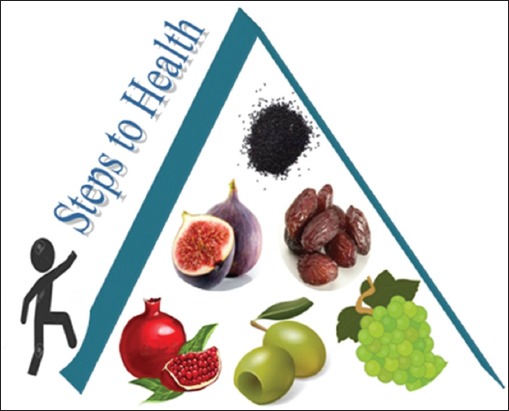
Table 1
Showing the links between superfoods and their health potentials
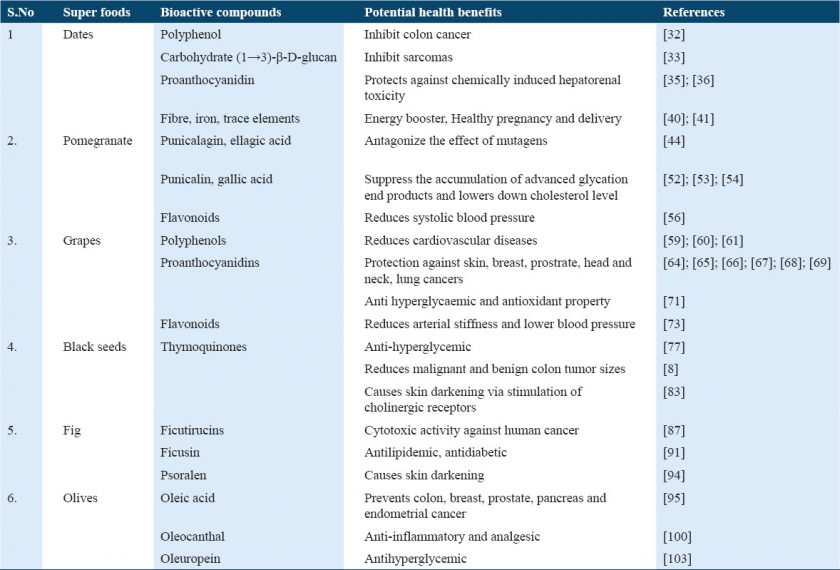
Superfoods and their Health Benefits
Dates (Phoenix dactylifera)
Dates are the staple food of the Middle East and very popular in Islamic countries. Dates were the most favored food of Prophet Muhammad ﷺ, who said, “If anyone is fasting, let him break his fast with dates. In case he does not have them, then with water.”[28,29] Its health benefits and nutritional value are well known across the world due to the presence of rich high profile nutrients and their health-promoting properties. Date palm (P. dactylifera L.) is a multipurpose tree providing fiber, carbohydrates, minerals, and vitamins besides having extreme medicinal properties.[28,30,31] Some of their medicinal properties are summarized.
Cancer
Polyphenol containing dates were found to have anticancer effects as reported by the study of Eid et al. (2014).[32] They have extracted polyphenols from Ajwa dates and demonstrated inhibitory effect on Caco-2 colon cancer cell line in vitro. Findings of Khan et al.[33] also showed the anticancer effect of antagonizing dates on human breast adenocarcinoma (MCF7) cells in vitro. Hence, we can say that MEAD may be used as an adjuvant therapy with conventional chemotherapeutic to achieve a synergistic effect against breast cancer. Some other component like carbohydrate (1→3)-β-D glucan isolated from Lebanon dates also found to have the same effect on sarcoma-180 in mice.[34]
Hepatopathy
Whenever a liver is damaged, the patient suffers from hepatic disturbance followed by liver failure. A major cause of liver failure is poisoning from certain chemical substances administered or produced in the body through drugs or medicines. Several studies prove the protective effect of dates on hepatorenal toxicity. Proanthocyanidin-rich dates can be used in treatment or prevention of toxic actions of different substances such as carbon tetrachloride (CCl4), thioacetamide (TAA), and dimethoate poisoning in liver.[35,36]
Diabetes
It is found that consuming low glycemic index (GI) diets are useful in the management of diabetes. Dates can be classified as low GI superfood, due to the presence of high fructose, as fructose is sweeter and less diabetogenic than glucose.[37,38] Hasan and Moheildin[39] evaluated the antidiabetic activity of two kinds of seed extracts (Ajwa and Sukkari of Kingdom of Saudi Arabia) on streptozotocin-induced diabetic rats. Long-term administration of the extract restores the function of liver and kidney and balances the oxidative stress condition in diabetic-treated rats.
Healthy pregnancy and delivery
For pregnant and postnatal women, the use of dates is particularly relevant. The consumption of dates by women before and after delivery can act as a tonic to strengthen the uterine muscles.[40] Al-Kuran et al.[41] concluded that the consumption of date fruit in the past 4 weeks before labor significantly reduced the need of labor induction and augmentation and produced a more favorable, delivery outcome. Thus, dates are the compact superfood, with a high fiber, iron, trace elements, antioxidant, rich energy content, along with low GI, a perfect choice for today’s health-conscious generation.
Pomegranate (Punica granatum)
Pomegranate (P. granatum) which is used as a fruit-bearing delicious shrub is the predominant member of two species comprising the Punicaceae family.[42] Pomegranate is widely consumed as juice, jam, and extracts.[44] Pomegranate has long been used to treat a variety of ailments.[45]
Cancer
Accumulating evidence suggests that pomegranate can stimulate many genes and proteins to suppress cancer growth and its progression. It is generally attributed to its high content of polyphenols. In addition, polyphenols of pomegranate such as punicalagin and ellagic acid have remarked antagonizing effects by inhibiting the effect of mutagens (i.e., sodium azide, benzo[a]pyrene, methyl methanesulfonate, and 2-aminoflourine), with maximum inhibition of mutagenicity up to 90%.[44] Pomegranate extract has also been reported to have chemopreventive role on breast,[45] colon,[46] hepatic,[47] skin,[48] and blood[49] cancers.
Memory disturbance
Polyphenols abundantly contained in pomegranate juice have potential neuroprotective effects. They help in augmenting our memory functions through the increase of important components for brain activation, as reported by West et al.[50] Other studies on mice suggested that it can also protect against Alzheimer’s disease.[51]
Diabetes
Consumption of concentrated pomegranate juice along with normal diet lowers down total (or low-density lipoprotein [LDL]) cholesterol level in type II diabetic patients with hyperlipidemia.[52-54] Accumulation of glycation end-product which leads to diabetic complications is suppressed by pomegranate fruit extract and its polyphenols such as punicalin, punicalagin, ellagic acid, and gallic acid.
Heart diseases and hypertension
Pomegranate is characterized by considerably high amounts of biologically active phytochemicals including flavonoids (e.g. anthocyanins, catechins, quercetin, and rutin), other types of polyphenols, ellagitannins, and antioxidant vitamins.[55] Juice consumption of pomegranate reduces systolic blood pressure and inhibits serum angiotensin-converting enzyme activity.[56] These hypotensive properties of pomegranate juice could be ascribed to the promising antioxidant properties of phytochemicals present in it, making it a powerful superfruit of recent times. Polyphenols present in pomegranate have an ability to inhibit LDL oxidation, macrophage foam cell formation, and atherosclerosis.[57]
Grapes (Vitis vinifera)
A grape, which is used as a fruiting berry of deciduous woody vines, is of botanical genus Vitis. Most grapes come from cultivars of V. vinifera, the European grapevine native to the Mediterranean and Central Asia. The Prophet Muhammad ﷺ was very fond of grapes. Grape-derived phytochemicals are used to cure various diseases.
Heart diseases
There is a wide variety of polyphenol compounds contained in grapes including flavonoids, phenolic acids, and resveratrol. The highest concentrations of grape polyphenols are found in the skin, stems, and seeds.[58] The evidence of various epidemiological researches suggests that the dietary intake of these compounds reduces cardiovascular mortality.[59-61] Many studies in vitro as well as in animals and humans demonstrate the beneficial effects of grape polyphenols on traditional cardiovascular risk factors.[62,63]
Cancer
During the past decade, numerous preclinical studies have been conducted using in vivo animal models and in vitro approaches, which show the protective effects of grape seed extract and its active constituents (proanthocyanidins) against skin,[64] breast,[65] prostate,[66] head and neck,[67,68] and lung[69] cancers. Recently, Mao et al.[70] have hypothesized that grape seed procyanidin extract exerts antineoplastic effects through modulations of oncomirs (micro RNA associated with carcinogenesis and malignant transformation) and their downstream targets.
Hyperglycemia and hypertension
An aqueous extract of grape leaves and seeds containing proanthocyanidins showed an antihyperglycemic and antioxidant effect.[71] There is a possibility that consumption of grapes or grape preparations may be beneficial to individuals with aberrant insulin responses to glucose.[72]
Grapes are rich in flavonoids, and the work of Dohadwala and Vita[73] has suggested that consumption of grapes and grapes containing products might lower blood pressure. Grape flavonoids have favorable effects on endothelial function and inflammation that might reduce arterial stiffness and lower blood pressure.[73] There has been a nocturnal dip in blood pressure which was observed by the consumption of grape juice.[74]
Black seeds (Nigella sativa)
Black seed (N. sativa) also known as kalonji, often called black cumin, is an annual flowering plant in the family Ranunculaceae, native to South and Southwest Asia. It is a widely used medicinal plant throughout the world. It is very popular in various traditional medicines such as Unani and Tibb, Ayurveda, and Siddha.[75,76] It is the black seeds referred to by Prophet Muhammad ﷺ, who once stated, “The black seed can heal every disease, except death”.
Diabetes
Thymoquinone is present in N. sativa, and it has proved that thymoquinone has the ability to improve hepatic enzyme activities and thereby exerts its potential antihyperglycemic effects.[77] A studies of Kanter et al.[78] have also demonstrated the protective effects of volatile oil of N. sativa seeds on insulin immunoreactivity and ultrastructural changes of pancreatic β-cells in streptozocin-induced diabetic rats. Effect of N. sativa on patients with type 2 diabetes was investigated by Bamosa et al.[79] The results of their experiments indicate that a dose of 2 g/day of N. sativa might be highly beneficial adjuvant to oral hypoglycemic agents in patients with type 2 diabetes. The combination of lipoic acid, carnitine, and N. sativa can contribute in the improvement of carbohydrate metabolism in diabetic rats.[80]
Cancer
It was revealed that crude oil of N. sativa has chemopreventive potential to cancer cells. Administration of 1000 or 4000 mg/L N. sativa volatile oil in the diet of male Wister rats for 30 weeks significantly reduced malignant and benign colon tumor sizes, incidences, and multiplicities.[81] Different extracts of N. sativa showed the cytotoxic effect on human MCF-7 breast cancer cells. Studies of Mahmoud and Torchilin[82] demonstrated that lipid extract N. sativa is cytotoxic to MCF-7 cells with LC50 of 2.720 ± 0.232 mg/ml, while its aqueous extract showed cytotoxicity when the applied concentration is high as about 50 mg/ml.
Hyperpigmentary disorders
Members of our group have reported very interesting finding[83] on hyperpigmentary activity of N. sativa. They showed that the extract of N. sativa, as well as its active principle, thymoquinone leads to skin darkening through stimulation of cholinergic receptors of muscarinic nature within the black skin cells, the melanophores of wall lizard, Hemydactylus flaviridis. The data of this interesting study have opened new vistas for the use of N. sativa and its active ingredient, thymoquinone, as a novel melanogen for its clinical application in skin disorders such as hypopigmentation or vitiligo. It must be mentioned that now, black seeds are assuming the status of a superfood, cheap and loaded with powerful medicinal properties.
Fig (Ficus carica)
F. carica belongs to Moraceae family and is commonly known as “Fig” (Anjir in Hindi), and the place of origin is the Middle East and Western Asia. Different plant parts such as fruits, seeds, leaves, tender, bark, shoots, and latex have numerous medicinal applications.[84]
Cancer
A mixture of 6-O-acyl-β-sitosterols was isolated as an effective cytotoxic agent from F. caricalatex. The mixture showed in vitro inhibitory effects on proliferation of various cancer cell lines.[85,86] Tirucallane-type triterpenoid compounds, ficutirucins, were isolated from F. carica, and their cytotoxic activity against human cancer cell lines, MCF-7, HepG-2, and U2OS was studied. Their results showed that all of them exhibited moderate cytotoxic activities against one or more of the three cancer cell lines.[87] Glioblastoma multiforme (GBM) is one of the worst human malignancies. Tezcan et al.[88] have investigated that F. carica latex prevents invasion through induction of let-7d expression in GBM cell lines.
Diabetes
The leaf extract of F. carica induced a significant hypoglycamic effect in oral or intraperitoneal administration in streptozotocin-diabetic rats. Weight loss was promoted in diabetic-treated rats, and plasma insulin levels considerably altered the survival index. The results indicated that the aqueous extract of F. carica has an obvious hypoglycemic activity.[89] It is also found that F. carica extract probably normalized the oxidative stress in streptozotocin-induced diabetic rats.[90] The effects of ficusin isolated from F. carica on GLUT4 translocation, and PPARγ expression in type 2 diabetic rats was examined and ficusin showed antidiabetic effects.[91]
Hypolipidemic and Hyperpigmentary
Hypotriglyceridemic activity of F. carica leaves in experimental hyper triglyceridemic rats was successfully studied by Perez et al.[92] Ficusin isolated from F. caricasignificantly lowered the serum antioxidant enzyme and lipids (total cholesterol [TC], triglycerides [TG], and free fatty acid) levels to near normal.[93] The leaf extract of F. carica could be a beneficial supplement to modulate TG and TC secretion in poultry liver. 8-week-old rooster’s liver with high abdominal fat was extracted; the sliced cells were cultured with a high concentration of F. carica leaf extract, insulin, or both of them. Addition of insulin stimulates the TG and TC secretion, and the level was higher than that of control. However, there was a significant reduction in TG and TC secretion when coincubated with leaf extract.[93]
Metei and Ali[94] in our group have demonstrated skin darkening effect of F. carica leaf extract and its bioactive compound psoralen in reptilian melanophores through cholinergic receptor stimulation. Hence, F. carica may be a good alternative for the treatment of hypopigmentary disorders.
Olives (Olea europaea)
Olive, O. europaea meaning “European olive,” is a species of small tree in the family Oleaceae. Extensive use of olive oil and olive leaves is cited in the Holy Bible as a natural healer. Prophet Muhammad ﷺ said “Eat olive oil and massage it over your bodies since it is a holy (Mubarak) tree”. He also stated that olive oil cures 70 diseases.
Cancer
Oleic acid present in olives has been found to be particularly effective against breast, colon, and prostate cancer cells. Eating olives could prevent the cell growth more than 25%, 15%, and 10% of colon, breast, and prostate cancers, respectively.[95] Oncology researchers proposed that oleic acid may fight cancer through its interference in human genome. They have found that oleic acid suppresses over expression of oncogenes and ultimately suppress the metastatis of many cancers.[96,97]
Rheumatoid arthritis
Increased olive oil consumption has been linked with a decreased risk of developing rheumatoid arthritis, an autoimmune disease characterized by inflammation and pain, particularly in the joints.[98] A clinical trial with olive oil was performed. Consequently, rheumatoid arthritis patients who supplemented their diets with olive oil and fish oil experienced more great improvement than the patients who supplemented with fish oil alone in clinical measurements of the disease.[99] These observations suggest that olive oil could help prevent rheumatoid arthritis and may restore mobility and function in those already affected by the disease.
Anti-inflammatory and analgesic
Oleocanthal found in olive oil is an in vitro cyclooxygenase inhibitor having anti-inflammatory and analgesic properties similar to the nonsteroidal anti-inflammatory drug ibuprofen. Oleocanthal may offer special protection against Alzheimer’s disease. A laboratory study found that oleocanthal alters the structure of neurotoxic proteins believed to contribute to the devastating effects of Alzheimer’s disease.[100] Studies of Donato-Trancoso, (2016)[101] showed that due to anti-inflammatory and antioxidant properties of olive oil, it is able to improve cutaneous wound healing of pressure ulcers in mice.
Diabetes
Several studies have shown that oleuropein present in olive leaves (up to 6%–9% of dry matter in the leaves) possesses a wide range of pharmacologic and health-promoting properties.[102] Especially, oleuropein has the ability to improve glucose metabolism and has been reported to have an antihyperglycemic effect in diabetic rats.[103]
Conclusion
From centuries, there has been a use of natural products including dietary components, herbs, and spices for the prevention of several diseases. Today, there is renewed interest in natural phytochemicals, as optimistic options for the development of more effective chemopreventive and chemotherapeutic strategies for a variety of incurable diseases. The present communication has focused on the efficacy of certain plant products against various diseases as recommended many years before, in an attempt to safeguard the deteriorating knowledge that can be used as a stepping stone for phytochemical and pharmacological analysis of these superfoods, without any side effects. Thus, the knowledge of the development of ideas related to the usage of superfoods as powerful medicines, their active ingredients responsible for treating a particular disease, and the actual mechanism by which they work to alleviate the diseases is very important, as it will increase the ability of modern pharmacists and physicians to respond to the severe challenges that are emerging with the spread of dreadful and incurable diseases.
References
1. Wolfe D. Superfoods:The Food and Medicines of the Future. California: North Atlantic Books Berkeley; 2009. [Google Scholar]
2. Li Y, Zhang JJ, Xu DP, Zhou T, Zhou Y, Li S, et al. Bioactivities and health benefits of wild fruits. Int J Mol Sci. 2016;17:1–27. [PMC free article] [PubMed] [Google Scholar]
3. Syed IB. Spiritual medicine in the history of Islamic medicine. J Int Soc History Islamic Med. 2003;2:45–50. [Google Scholar]
4. Deuraseh N. Health and medicine in the Islamic tradition based on the book of medicine Kitab Al-tibb of Sahih Al-Bukhari. J Int Soc History Islamic Med. 2006;5:2–14. [Google Scholar]
5. Sarkhel S. Ethnomedicinal uses of some plants in treatment of jaundice by tribal communities of Paschim Medinipur district, West Bengal, India. Med Aromat Plants. 2015;4:1–4. [Google Scholar]
6. Saad B, Azaizeh H, Said O. Tradition and perspective of Arab herbal medicine:A review. Evid based Complement Altern Med. 2005;2:475–9. [PMC free article] [PubMed] [Google Scholar]
7. Gibbs JB, Oliff A. Pharmaceutical research in molecular oncology. Cell. 1994;79:193–8. [PubMed] [Google Scholar]
8. Mokdad AH, Dwyer-Lindgren L, Fitzmaurice C, Stubbs RW, Bertozzi-Villa A, Morozoff C, et al. Trends and patterns of disparities in cancer mortality among US counties 1980-2014. JAMA. 2017;317:388–406.[PMC free article] [PubMed] [Google Scholar]
9. Feng SS, Chienc S. Chemotherapeutic engineering:Application and further development of chemical engineering principles for chemotherapy of cancer and other diseases. Chem Eng Sci. 2003;58:4087–114.[Google Scholar]
10. Brigger I, Dubernet C, Couvreur P. Nanoparticles in cancer therapy and diagnosis. Adv Drug Deliv Rev. 2002;54:631–51. [PubMed] [Google Scholar]
11. Aghabati N, Mohammadi E, Esmaiel ZP. The effect of therapeutic touch on pain and fatigue of cancer patients undergoing chemotherapy. Evid Based Complement Altern Med. 2010;7:375–81.[PMC free article] [PubMed] [Google Scholar]
12. Krawczuk-Rybak M, Tomczuk-Ostapczuk M, Panasiuk A, Goscik E. Carotid intima-media thickness in young survivors of childhood cancer. J Med Imaging Radiat Oncol. 2016 DOI:10.1111/1754-9485.12510. [PubMed] [Google Scholar]
13. Wild S, Roglic G, Green A, Sicree R, King H. Global prevalence of diabetes:Estimates for the year 2000 and projections for 2030. Diabetes Care. 2004;27:1047–53. [PubMed] [Google Scholar]
14. Kasuga M. Insulin resistance and pancreatic beta cell failure. J Clin Invest. 2006;116:1756–60.[PMC free article][PubMed] [Google Scholar]
15. Bailey CJ, Day C. Antidiabetic drugs. Br J Cardiol. 2003;10:128–36. [Google Scholar]
16. Hermansen K, Mortensen LS, Hermansen ML. Combining insulins with oral antidiabetic agents:Effect on hyperglycemic control, markers of cardiovascular risk and disease. Vasc Health Risk Manag. 2008;4:561–74. [PMC free article] [PubMed] [Google Scholar]
17. Meece J. Dispelling myths and removing barriers about insulin in Type 2 diabetes. Diabetes Educ. 2006;32:9S–18. [PubMed] [Google Scholar]
18. Shi Z, Ma L, Wang H, Yang Y, Li X, Schreiber A, et al. Insulin and hypertonic glucose in the management of aseptic fat liquefaction of post-surgical incision:A meta-analysis and systematic review. Int Wound J. 2013;10:91–7. [PMC free article] [PubMed] [Google Scholar]
19. Wong CY, Martinez J, Dass CR. Oral delivery of insulin for treatment of diabetes:Status quo, challenges and opportunities. J Pharm Pharmacol. 2016;68:1093–108. [PubMed] [Google Scholar]
20. Haslam DW, James WP. Obesity. Lancet. 2005;366:1197–209. [PubMed] [Google Scholar]
21. Kushner RF, Bessesen DH. Treatment of the obese patient. Endocrinology. 2009;158:916–29.[Google Scholar]
22. Bergmann KL, Cox SJ, Tabone LE. Influence of a rural environment on patient access and outcomes for bariatric surgery. Surg Obeset Relat Dis. 2016;S1550-S(7289):30812–7. [Google Scholar]
23. Brethauer SA, Chand B, Schauer PR. Risks and benefits of bariatric surgery:Current evidence. Cleve Clin J Med. 2006;73:993–1007. [PubMed] [Google Scholar]
24. Cepeda-Lopez AC, Allende-Labastida J, Melse-Boonstra A, Osendarp SJ, Herter-Aeberli I, Moretti D, et al. The effects of fat loss after bariatric surgery on inflammation, serum hepcidin, and iron absorption:A prospective 6-mo iron stable isotope study. Am J Clin Nutr. 2016;104:1030–8. [PubMed] [Google Scholar]
25. Loya AM, González-Stuart A, Rivera JO. Prevalence of polypharmacy, polyherbacy, nutritional supplement use and potential product interactions among older adults living on the United States-Mexico border:A descriptive, questionnaire-based study. Drugs Aging. 2009;26:423–36. [PubMed] [Google Scholar]
26. Cohen PA, Ernst E. Safety of herbal supplements:A guide for cardiologists. Cardiovasc Ther. 2010;28:246–53. [PubMed] [Google Scholar]
27. Son MJ, Im HJ, Kim YE, Ku B, Lee JH, Son CG. Evaluation of the anti-fatigue effects of a traditional herbal drug, Gongjin-Dan, under insufficient sleep conditions:Study protocol for a randomised controlled trial. Trials. 2016;17:418. [PMC free article] [PubMed] [Google Scholar]
28. Vayalil PK. Antioxidant and antimutagenic properties of aqueous extract of date fruit (Phoenix dactylifera L Arecaceae) J Agric Food Chem. 2002;50:610–7. [PubMed] [Google Scholar]
29. Al-Farsi MA, Lee CY. Nutritional and functional properties of dates:A review. Crit Rev Food Sci Nutr. 2008;48:877–87. [PubMed] [Google Scholar]
30. Al-Farsi M, Alasalvar C, Morris A, Baron M, Shahidi F. Comparison of antioxidant activity, anthocyanins, carotenoids, and phenolics of three native fresh and sun-dried date (Phoenix dactylifera L.) varieties grown in oman. J Agric Food Chem. 2005;53:7592–9. [PubMed] [Google Scholar]
31. Hanano A, Almousally I, Shaban M, Rahman F, Hassan M, Murphy DJ. Specific caleosin/peroxygenase and lipoxygenase activities are tissue-differentially expressed in date palm (Phoenix dactylifera L.) seedlings and are further induced following exposure to the toxin 2,3,7,8-tetrachlorodibenzo-p-dioxin. Front Plant Sci. 2017;7:2025. [PMC free article] [PubMed] [Google Scholar]
32. Eid N, Enani S, Walton G, Corona G, Costabile A, Gibson G, et al. The impact of date palm fruits and their component polyphenols, on gut microbialecology, bacterial metabolites and colon cancer cell proliferation. J Nutr Sci. 2014;3:1–9. [PMC free article] [PubMed] [Google Scholar]
33. Khan F, Ahmed F, Pushparaj PN, Abuzenadah A, Kumosani T, Barbour E, et al. Ajwa date (Phoenix dactylifera L.) extract inhibits human breast adenocarcinoma (MCF7) cells in vitro by inducing apoptosis and cell cycle arrest. PLoS One. 2016;11:e0158963. [PMC free article] [PubMed] [Google Scholar]
34. Ishurd O, Zgheel F, Kermagi A, Flefla M, Elmabruk M. Antitumor activity of β-D-glucan from Libyan dates. J Med Food. 2004;7:252–5. [PubMed] [Google Scholar]
35. Saafi EB, Louedi M, Elfeki A, Zakhama A, Najjar MF, Hammami M, et al. Protective effect of date palm fruit extract (Phoenix dactylifera L.). on dimethoate induced-oxidative stress in rat liver. Exp Toxicol Pathol. 2011;63:433–41. [PubMed] [Google Scholar]
36. Ahmed AF, Al-Qahtani JH, Al-Yousef HM, Al-Said MS, Ashour AE, Al-Sohaibani M, et al. Proanthocyanidin-rich date seed extract protects against chemically induced hepatorenal toxicity. J Med Food. 2015;18:280–9. [PMC free article] [PubMed] [Google Scholar]
37. Miller CJ, Dunn EV, Hashim IB. The glycaemic index of dates and date/yoghurt mixed meals. Are dates 'the candy that grows on trees'? Eur J Clin Nutr. 2003;57:427–30. [PubMed] [Google Scholar]
38. Ovbiagele B, Markovic D, Fonarow GC. Recent US patterns and predictors of prevalent diabetes among acute myocardial infarction patients. Cardiol Res Pract. 2011;2011:145615. [PMC free article][PubMed] [Google Scholar]
39. Hasan M, Mohieldein AB. In vivo evaluation of anti diabetic, hypolipidemic, antioxidative activities of Saudi date seed extract on streptozotocin induced diabetic rats. J Clin Diagn Res. 2016;10:6–12.[PMC free article] [PubMed] [Google Scholar]
40. El-Moughy SA, Abdel-Aziz SA, Al-Shanawany M, Omar A. The gonadotropic activity of palmae in mature rats. Alex J Pharm Res. 1991;5:156–9. [Google Scholar]
41. Al-Kuran O, Al-Mehaisen L, Bawadi H, Beitawi S, Amarin Z. The effect of late pregnancy consumption of date fruit on labour and delivery. J Obstet Gynaecol. 2011;31:29–31. [PubMed] [Google Scholar]
42. Gu L, Kelm MA, Hammerstone JF, Beecher G, Holden J, Haytowitz D, et al. Concentrations of proanthocyanidins in common foods and estimations of normal consumption. J Nutr. 2004;134:613–7.[PubMed] [Google Scholar]
43. Lansky EP, Newman RA. Punica granatum (Pomegranate) and its potential for prevention and treatment of inflammation and cancer. J Ethnopharmacol. 2007;109:177–206. [PubMed] [Google Scholar]
44. Zahin M, Ahmad I, Gupta RC, Aqil F. Punicalagin and ellagic acid demonstrate antimutagenic activity and inhibition of benzo[a]pyrene induced DNA adducts. Biomed Res Int. 2014;2014:467465.[PMC free article] [PubMed] [Google Scholar]
45. Dai Z, Nair V, Khan M, Ciolino HP. Pomegranate extract inhibits the proliferation and viability of MMTV-wnt-1 mouse mammary cancer stem cells in vitro. Oncol Rep. 2010;24:1087–91. [PubMed] [Google Scholar]
46. Sadik NA, Shaker OG. Inhibitory effect of a standardized pomegranate fruit extract on Wnt signalling 1,2 dimethyl hydrazine induced rat colon carcinogenesis. Dig Dis Sci. 2013;58:2507–17. [PubMed] [Google Scholar]
47. Bhatia D, Thoppil RJ, Mandal A, Samtani KA, Darvesh AS, Bishayee A. Pomegranate bioactive constituents suppress cell proliferation and induce apoptosis in an experimental model of hepatocellular carcinoma:Role of Wnt/βcatenin signalling pathway. Evid Based Complement Altern Med. 2013;2013:1–15. [PMC free article] [PubMed] [Google Scholar]
48. George J, Singh M, Srivastava AK, Bhui K, Shukla Y. Synergistic growth inhibition of mouse skin tumors by pomegranate fruit extract and diallyl sulfide:Evidence for inhibition of activated MAPKs/NF-kB and reduced cell proliferation. Food Chem Toxicol. 2011;49:1511–20. [PubMed] [Google Scholar]
49. Dahlawi H, Jordan-Mahy N, Clench MR, Le Maitre CL. Bioactive actions of pomegranate fruit extracts on leukemia cell lines in vitro hold promise for new therapeutic agents for leukemia. Nutr Cancer. 2012;64:100–10. [PubMed] [Google Scholar]
50. West T, Atzeva M, Holtzman DM. Pomegranate polyphenols and resveratrol protect the neonatal brain against hypoxic-ischemic injury. Dev Neurosci. 2007;29:363–72. [PMC free article] [PubMed] [Google Scholar]
51. Rojanathammanee L, Puig KL, Combs CK. Pomegranate polyphenols and extract inhibit nuclear factor of activated T-cell activity and microglial activation in vitro and in a transgenic mouse model of Alzheimer disease. J Nutr. 2013;143:597–605. [PMC free article] [PubMed] [Google Scholar]
52. Esmaillzadeh A, Tahbaz F, Gaieni I, Alavi-Majd H, Azadbakht L. Cholesterol-lowering effect of concentrated pomegranate juice consumption in Type II diabetic patients with hyperlipidemia. Int J Vitam Nutr Res. 2006;76:147–51. [PubMed] [Google Scholar]
53. Ito H, Li P, Koreishi M, Nagatomo A, Nishida N, Yoshida T. Ellagitannin oligomers and a neolignan from pomegranate arils and their inhibitory effects on the formation of advanced glycation end products. Food Chem. 2013;152:323–30. [PubMed] [Google Scholar]
54. Kumagai Y, Nakatani S, Onodera H, Nagatomo A, Nishida N, Matsura Y, et al. Anti-glycation effects of Pomegranate (Punica granatum L.) fruit extract and its components in vivo and in vitro. J Agric Food Chem. 2015;63:7760–4. [PubMed] [Google Scholar]
55. Stowe CB. The effects of pomegranate juice consumption on blood pressure and cardiovascular health. Complement Ther Clin Pract. 2011;17:113–5. [PubMed] [Google Scholar]
56. Asgary S, Sahebkar A, Afshani MR, Keshvari M, Haghjooyjavanmard S, Rafieian-Kopaei M, et al. Clinical evaluation of blood pressure lowering, endothelial function improving, hypolipidemic and anti-inflammatory effects of pomegranate juice in hypertensive subjects. Phytother Res. 2014;28:193–9.[PubMed] [Google Scholar]
57. Aviram M, Dornfeld L, Kaplan M, Coleman R, Gaitini D, Nitecki S, et al. Pomegranate juice flavonoids inhibit low-density lipoprotein oxidation and cardiovascular diseases:Studies in atherosclerotic mice and in humans. Drugs Exp Clin Res. 2002;28:49–62. [PubMed] [Google Scholar]
58. Sparwel J, Vantler M, Caglayan E, Kappert K, Fries JW, Dietrich H, et al. Differential effects of red and white wines on inhibition of the platelet-derived growth factor receptor:Impact of the mash fermentation. Cardiovasc Res. 2009;81:758–70. [PubMed] [Google Scholar]
59. Hertog MG, Kromhout D, Aravanis C, Blackburn H, Buzina R, Fidanza F, et al. Flavonoid intake and long-term risk of coronary heart disease and cancer in the seven countries study. Arch Intern Med. 1995;155:381–6. [PubMed] [Google Scholar]
60. Arts IC, Hollman PC, Feskens EJ, Bueno de Mesquita HB, Kromhout D. Catechin intake and associated dietary and lifestyle factors in a representative sample of Dutch men and women. Eur J Clin Nutr. 2001;55:76–81. [PubMed] [Google Scholar]
61. Geleijnse JM, Launer LJ, Van der Kuip DA, Hofman A, Witteman JC. Inverse association of tea and flavonoid intakes with incident myocardial infarction:The Rotterdam study. Am J Clin Nutr. 2002;75:880–6. [PubMed] [Google Scholar]
62. Blumberg JB, Vita JA, Chen CY. Concord grape juice polyphenols and cardiovascular risk factors:Dose-response relationships. Nutrients. 2015;7:10032–52. [PMC free article] [PubMed] [Google Scholar]
63. Rasines-Perea Z, Teissedre PL. Grape polyphenols'effects in human cardiovascular diseases and diabetes. Molecules. 2017;22:E68. [PMC free article] [PubMed] [Google Scholar]
64. Mittal A, Elmets CA, Katiyar SK. Dietary feeding of proanthocyanidins from grape seeds prevents photocarcinogenesis in SKH-1 hairless mice:Relationship to decreased fat and lipid peroxidation. Carcinogenesis. 2003;24:1379–88. [PubMed] [Google Scholar]
65. Mantena SK, Baliga MS, Katiyar SK. Grape seed proanthocyanidins induce apoptosis and inhibit metastasis of highly metastatic breast carcinoma cells. Carcinogenesis. 2006;27:1682–91. [PubMed] [Google Scholar]
66. Raina K, Singh RP, Agarwal R, Agarwal C. Oral grape seed extract inhibits prostate tumor growth and progression in TRAMP mice. Cancer Res. 2007;67:5976–82. [PubMed] [Google Scholar]
67. Sun Q, Prasad R, Rosenthal E, Katiyar SK. Grape seed proanthocyanidins inhibit the invasiveness of human HNSCC cells by targeting EGFR and reversing the epithelial-to-mesenchymal transition. PLoS One. 2012;7:e31093. [PMC free article] [PubMed] [Google Scholar]Retracted
68. Prasad R, Katiyar SK. Bioactive phytochemical proanthocyanidins inhibit growth of head and neck squamous cell carcinoma cells by targeting multiple signaling molecules. PLoS One. 2012;7:e46404.[PMC free article] [PubMed] [Google Scholar]
69. Sharma SD, Meeran SM, Katiyar SK. Proanthocyanidins inhibit in vitro and in vivo growth of human non-small cell lung cancer cells by inhibiting the prostaglandin E(2) and prostaglandin E(2) receptors. Mol Cancer Ther. 2010;9:569–80. [PubMed] [Google Scholar]
70. Mao JT, Xue B, Lu JS, Park H, Henning SM, Burns W, et al. MicroRNA-19a/b mediates grape seed procyanidin extract-induced anti-neoplastic effects against lung cancer. JNutr Biochem. 2016;34:118–25.[PubMed] [Google Scholar]
71. Orhan N, Aslan M, Orhan DD, Ergun F, Yeşilada E. In-vivo assessment of antidiabetic and antioxidant activities of grapevine leaves (Vitis vinifera) in diabetic rats. J Ethnopharmacol. 2006;108:280–6.[PubMed] [Google Scholar]
72. Zunino SJ. Type 2 diabetes and glycemic response to grapes or grape products. J Nutr. 2009;26:1794–800. [PubMed] [Google Scholar]
73. Dohadwala MM, Vita JA. Grapes and cardiovascular disease. J Nutr. 2009;139:1788S–93.[PMC free article][PubMed] [Google Scholar]
74. Dohadwala MM, Hamburg NM, Holbrook M, Kim BH, Duess MA, Levit A, et al. Effects of concord grape juice on ambulatory blood pressure in prehypertension and stage 1 hypertension. Am J Clin Nutr. 2010;92:1052–9. [PMC free article] [PubMed] [Google Scholar]
75. Goreja WG. Black Seed:Nature's Miracle Remedy. New York, NY: Amazing Herbs Press; 2003. [Google Scholar]
76. Sharma PC, Yelne MB, Dennis TJ. Database on Medicinal Plants used in Ayurveda. New Delhi: Central Council for Research in Ayurveda &Siddha, Department of ISM &H, Ministry of Health & Family Welfare, Government of India; 2005. pp. 420–40. [Google Scholar]
77. Pari L, Sankaranarayanan C. Beneficial effects of thymoquinone on hepatic key enzymes in streptozotocin-nicotinamide induced diabetic rats. Life Sci. 2009;85:830–4. [PubMed] [Google Scholar]
78. Kanter M, Akpolat M, Aktas C. Protective effects of the volatile oil of Nigella sativa seeds on beta-cell damage in streptozotocin-induced diabetic rats:A light and electron microscopic study. J Mol Histol. 2009;40:379–85. [PubMed] [Google Scholar]
79. Bamosa AO, Kaatabi H, Lebdaa FM, Elq AM, Al-Sultanb A. Effect of Nigella sativa seeds on the glycemic control of patients with Type 2 diabetes mellitus. Indian J Physiol Pharmacol. 2010;54:344–54.[PubMed] [Google Scholar]
80. Salama RH. Hypoglycemic effect of lipoic acid, carnitine and Nigella sativa in diabetic rat model. Int J Health Sci (Qassim) 2011;5:126–34. [PMC free article] [PubMed] [Google Scholar]
81. Salim EI. Cancer chemopreventive potential of volatile oil from black cumin seeds Nigella sativa L. In a rat multi-organ carcinogenesis bioassay. Oncol Lett. 2010;1:913–24. [PMC free article] [PubMed] [Google Scholar]
82. Mahmoud SS, Torchilin VP. Hormetic/cytotoxic effects of Nigella sativa seed alcoholic and aqueous extracts on MCF-7 breast cancer cells alone or in combination with doxorubicin. Cell Biochem Biophys. 2012;25:1392–8. [PubMed] [Google Scholar]
83. Ali SA, Metei KV. Nigella sativa seed extract and its bioactive compound thymoquinone:The new melanogens causing hyperpigmentation in the wall lizard melanophores. J Pharm Pharmacol. 2011;63:741–6. [PubMed] [Google Scholar]
84. Joseph B, Raj SJ. A comparative study on various properties of five medicinally important plants. Int J Pharm. 2011;7:206–11. [Google Scholar]
85. Rubnov S, Kashman Y, Rabinowitz R, Schlesinger M, Mechoulam R. Suppressors of cancer cell proliferation from fig (Ficus carica) resin:Isolation and structure elucidation. J Nat Prod. 2001;64:993–6.[PubMed] [Google Scholar]
86. Yancheva SD, Golubowicz S, Yablowicz Z, Perl A. Efficient agrobacterium-mediated transformation and recovery of transgenic fig (Ficus carica L.) plants. Plant Sci. 2005;168:1433–41. [Google Scholar]
87. Jing L, Zhang YM, Luo JG, Kong LY. Tirucallane-type triterpenoids from the fruit of Ficus carica and their cytotoxic activity. Chem Pharm Bull (Tokyo) 2015;63:237–43. [PubMed] [Google Scholar]
88. Tezcan G, Tunca B, Bekar A, Yalcin M, Sahin S, Budak F, et al. Ficus carica latex prevents invasion through induction of let-7d expression in GBM cell lines. Cell Mol Neurobiol. 2015;35:175–87. [PubMed] [Google Scholar]
89. Perez C, Domınguez E, Ramiro JM, Romero A, Campillo JE, Torres MD. A study on the glycaemic balance in streptozotocin-diabetic rats treated with an aqueous extract of Ficus carica (figtree) leaves. Phytother Res. 1998;10:82–3. [Google Scholar]
90. Pèrez C, Canal JR, Torres MD. Experimental diabetes treated with Ficuscarica extract:Effect on oxidative stress parameters. Acta Diabetol. 2003;40:3–8. [PubMed] [Google Scholar]
91. Irudayaraj SS, Stalin A, Sunil C, Duraipandiyan V, Al-Dhabi NA, Ignacimuthu S. Antioxidant, antilipidemic and antidiabetic effects of ficusin with their effects on GLUT4 translocation and PPARγexpression in Type 2 diabetic rats. Chem Biol Interact. 2016;256:85–93. [PubMed] [Google Scholar]
92. Pérez C, Canal JR, Campillo JE, Romero A, Torres MD. Hypotriglyceridaemic activity of Ficus caricaleaves in experimental hypertriglyceridemia rats. Phytother Res. 1999;13:188–91. [PubMed] [Google Scholar]
93. Asadi F, Pourkabir M, Maclaren R, Shahriari A. Alterations to lipid parameters in response to fig tree (Ficus carica) leaf extract in chicken liver slices. Turk J Vet Anim Sci. 2006;30:315–8. [Google Scholar]
94. Meitei KV, Ali SA. Fig leaf extract and its bioactive compound psoralen induces skin darkening effect in reptilian melanophores via cholinergic receptor stimulation. In Vitro Cell Dev Biol Anim. 2012;48:335–9. [PubMed] [Google Scholar]
95. La Vecchia C. Mediterranean diet and cancer. Public Health Nutr. 2004;7:965–8. [PubMed] [Google Scholar]
96. Visioli F, Grande S, Bogani P, Galli C. The role of antioxidants in the Mediterranean dates:Focus on cancer. Eur J Cancer Prev. 2004;13:337–43. [PubMed] [Google Scholar]
97. Menendez JA, Vazquez-Martin A, Garcia-Villalba R, Carrasco-Pancorbo A, Oliveras-Ferraros C, Fernandez-Gutierrez A, et al. TabAnti-HER2 (erbB-2) oncogene effects of phenolic compounds directly isolated from commercial extra-virgin olive oil (EVOO) BMC Cancer. 2008;8:377. [PMC free article][PubMed] [Google Scholar]
98. Wahle KW, Caruso D, Ochoa JJ, Quiles JL. Olive oil and modulation of cell signaling in disease prevention. Lipids. 2004;39:1223–31. [PubMed] [Google Scholar]
99. Berbert AA, Kondo CR, Almendra CL, Matsuo T, Dichi I. Supplementation of fish oil and olive oil in patients with rheumatoid arthritis. Nutrition. 2005;21:131–6. [PubMed] [Google Scholar]
100. Pitt J, Roth W, Lacor P, Blankenship M, Velasco P, de Felice F, et al. Alzheimer's-associated Aβoligomers show altered structure, immunoreactivity and synaptotoxicity with low doses of oleocanthal. Toxicol Appl Pharm. 2009;240:189–97. [PMC free article] [PubMed] [Google Scholar]
101. Donato-Trancoso A, Monte-Alto-Costa A, Romana-Souza B. Olive oil-induced reduction of oxidative damage and inflammation promotes wound healing of pressure ulcers in mice. J Dermatol Sci. 2016;83:60–9. [PubMed] [Google Scholar]
102. Briante R, Patumi M, Terenziani S, Bismuto E, Febbraio F, Nucci R, et al. Olea europaea L. Leaf extract and derivatives:Antioxidant properties. J Agric Food Chem. 2002;17:4934–40. [PubMed] [Google Scholar]
103. Jemai H, El Feki A, Sayadi S. Antidiabetic and antioxidant effects of hydroxytyrosol and oleuropein from olive leaves in alloxan-diabetic rats. J Agric Food Chem. 2009;57:8798–804. [PubMed] [Google Scholar]
( Source: Courtesy of Qassim University; Article republished from the International Journal of Health Sciences, 2018 Mar-Apr; 12(2): 61–69; "Links between the Prophet Muhammad ﷺ recommended foods and disease management: A review in the light of modern superfoods", accessible at U.S. National Library of Medicine. This is an open-access article distributed under the terms of the Creative Commons Attribution-Noncommercial-Share Alike 3.0 )
Topics: Diet, Health, Natural Foods, Nutrition, Prophet Muhammad (S)
Views: 14642
Related Suggestions















